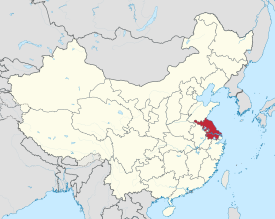Kiangsu
|
Jiangsu Province 江苏省 |
|
|---|---|
| Province | |
| Name transcription(s) | |
| • Chinese | 江苏省 (Jiāngsū Shěng) |
| • Abbreviation | (pinyin: Sū) |
| • Wu | Kaonsu San |
 Map showing the location of Jiangsu Province |
|
| Coordinates: 32°54′N 119°48′E / 32.9°N 119.8°ECoordinates: 32°54′N 119°48′E / 32.9°N 119.8°E | |
| Named for |
Jiangning (now Nanjing) Suzhou |
| Capital | Nanjing |
| Largest city | Suzhou |
| Divisions | 13 prefectures, 106 counties, 1488 townships |
| Government | |
| • Secretary | Li Qiang |
| • Governor | Shi Taifeng |
| Area | |
| • Total | 102,600 km2 (39,600 sq mi) |
| Area rank | 25th |
| Population (2015) | |
| • Total | 79,800,000 |
| • Rank | 5th |
| • Density | 780/km2 (2,000/sq mi) |
| • Density rank | 4th |
| Demographics | |
| • Ethnic composition |
Han – 99.6% Hui – 0.2% |
| • Languages and dialects |
Mandarin (Official) Jianghuai Mandarin, Wu, Zhongyuan Mandarin |
| ISO 3166 code | CN-32 |
| GDP (2016) |
CNY 7.61 trillion USD 1.14 trillion (2nd) |
| • per capita |
CNY 95,238 USD 14,341 (4th) |
| • growth |
|
| HDI (2010) | 0.748 (high) (4th) |
| Website | www |
| Jiangsu | |||||||||||||||||||||||||||||

"Jiangsu" in Simplified (top) and Traditional (bottom) Chinese characters
|
|||||||||||||||||||||||||||||
| Simplified Chinese | 江苏 | ||||||||||||||||||||||||||||
|---|---|---|---|---|---|---|---|---|---|---|---|---|---|---|---|---|---|---|---|---|---|---|---|---|---|---|---|---|---|
| Traditional Chinese | 江蘇 | ||||||||||||||||||||||||||||
| Postal | Kiangsu | ||||||||||||||||||||||||||||
| Literal meaning | Nanjing (from its former name Jiangning) and Suzhou | ||||||||||||||||||||||||||||
|
|||||||||||||||||||||||||||||
| Transcriptions | |
|---|---|
| Standard Mandarin | |
| Hanyu Pinyin | Jiāngsū |
| Bopomofo | ㄐㄧㄤ ㄙㄨ |
| Gwoyeu Romatzyh | Jiangsu |
| Wade–Giles | Chiang1-su1 |
| IPA | [tɕjáŋsú] |
| Wu | |
| Romanization | Kaon-su |
| Yue: Cantonese | |
| Yale Romanization | Gōng-sōu |
| Jyutping | Gong1-sou1 |
| Southern Min | |
| Tâi-lô | Kang-soo |
Jiangsu (![]() listen ), formerly romanized as Kiangsu, is an eastern-central coastal province of the People's Republic of China, one of the leading provinces in manufacturing electronics and apparel items, with its capital in Nanjing. Jiangsu is the third smallest, but the fifth most populous and the most densely populated of the 23 provinces of the People's Republic of China. Jiangsu has the second-highest GDP of Chinese provinces, after Guangdong. Jiangsu borders Shandong in the north, Anhui to the west, and Zhejiang and Shanghai to the south. Jiangsu has a coastline of over 1,000 kilometres (620 mi) along the Yellow Sea, and the Yangtze River passes through the southern part of the province.
listen ), formerly romanized as Kiangsu, is an eastern-central coastal province of the People's Republic of China, one of the leading provinces in manufacturing electronics and apparel items, with its capital in Nanjing. Jiangsu is the third smallest, but the fifth most populous and the most densely populated of the 23 provinces of the People's Republic of China. Jiangsu has the second-highest GDP of Chinese provinces, after Guangdong. Jiangsu borders Shandong in the north, Anhui to the west, and Zhejiang and Shanghai to the south. Jiangsu has a coastline of over 1,000 kilometres (620 mi) along the Yellow Sea, and the Yangtze River passes through the southern part of the province.
Since the Sui and Tang dynasties, Jiangsu has been a national economic and commercial center, partly due to the construction of Grand Canal. Cities such as Yangzhou, Nanjing, Wuxi, Suzhou and Shanghai (separated from Jiangsu in 1927) are all major Chinese economic hubs. Since the initiation of economic reforms in 1990, Jiangsu has become a focal point for economic development. It is widely regarded as China's most developed province measured by its Human Development Index (HDI). However, its development is not evenly distributed, with the Wu-speaking southern part of the province being significantly more well-off than its Mandarin-speaking north, which sometimes causes tensions between northern and southern residents.
...
Wikipedia
